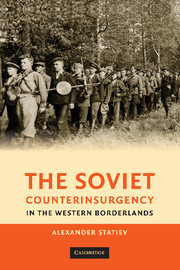Book contents
- Frontmatter
- Contents
- List of Figures
- List of Tables
- Acknowledgments
- Glossary
- Introduction
- 1 Origins of Soviet Counterinsurgency
- 2 The Borderland Societies in the Interwar Period: The First Soviet Occupation and the Emergence of Nationalist Resistance
- 3 The Borderlands under German Occupation (1941–1944): Social Context of the Soviet Reconquest
- 4 Nationalist Resistance after the Soviet Reconquest
- 5 Soviet Agrarian Policy as a Pacification Tool
- 6 Deportations, “Repatriations,” and Other Types of Forced Migration as Aspects of Security Policy
- 7 Amnesties
- 8 Red Rurales: The Destruction Battalions
- 9 Police Tactics: Actions of NKVD Security Units, Intelligence Gathering, Covert Operations, and Intimidation
- 10 The Church in Soviet Security Policy
- 11 Violations of Official Policy and Their Impact on Pacification
- 12 Conclusion: Nationalist Resistance and Soviet Counterinsurgency in the Global Context
- Appendix A Note on Used Terms and Geographic and Personal Names
- Appendix B Note on Primary Sources
- Bibliography
- Index
1 - Origins of Soviet Counterinsurgency
Published online by Cambridge University Press: 05 May 2010
- Frontmatter
- Contents
- List of Figures
- List of Tables
- Acknowledgments
- Glossary
- Introduction
- 1 Origins of Soviet Counterinsurgency
- 2 The Borderland Societies in the Interwar Period: The First Soviet Occupation and the Emergence of Nationalist Resistance
- 3 The Borderlands under German Occupation (1941–1944): Social Context of the Soviet Reconquest
- 4 Nationalist Resistance after the Soviet Reconquest
- 5 Soviet Agrarian Policy as a Pacification Tool
- 6 Deportations, “Repatriations,” and Other Types of Forced Migration as Aspects of Security Policy
- 7 Amnesties
- 8 Red Rurales: The Destruction Battalions
- 9 Police Tactics: Actions of NKVD Security Units, Intelligence Gathering, Covert Operations, and Intimidation
- 10 The Church in Soviet Security Policy
- 11 Violations of Official Policy and Their Impact on Pacification
- 12 Conclusion: Nationalist Resistance and Soviet Counterinsurgency in the Global Context
- Appendix A Note on Used Terms and Geographic and Personal Names
- Appendix B Note on Primary Sources
- Bibliography
- Index
Summary
Chto s popom, chto s kulakom vsia beseda –
V briukho tolstoe shtykom miroeda!
[Don't talk with a priest or a kulak –
Just stab the bloodsuckers' fat bellies with your bayonet!]
Dem'ian Bednyi, “Red Army Song”At the beginning of the twentieth century, Russia was an agrarian state: 80 percent of its population lived in the countryside. Most arable land in the European part of Russia belonged to the aristocracy, the Crown, and the church, whereas most peasants suffered from land shortage aggravated by the antique organization of peasant labor and backward agricultural methods. After the Bolsheviks took power in November 1917, they promptly addressed this grave problem that had tormented the Russian countryside for half a century. They enforced a radical agrarian reform, which secured the support of peasants throughout the revolution and most of the civil war that followed it. However, in 1919, when the Bolsheviks began confiscating peasant grain in the name of the starving proletariat, they provoked a wave of large rural uprisings, which they doggedly fought until early 1921. This chapter discusses the origins of Soviet counterinsurgency doctrine and its evolution during the interwar period. The lessons the Soviet leaders learned from the experience of the revolution and the civil war, coupled with the security policies developed afterward, laid the foundation for the class-based counterinsurgency model they later applied in the western borderlands.
- Type
- Chapter
- Information
- The Soviet Counterinsurgency in the Western Borderlands , pp. 13 - 34Publisher: Cambridge University PressPrint publication year: 2010
- 2
- Cited by



